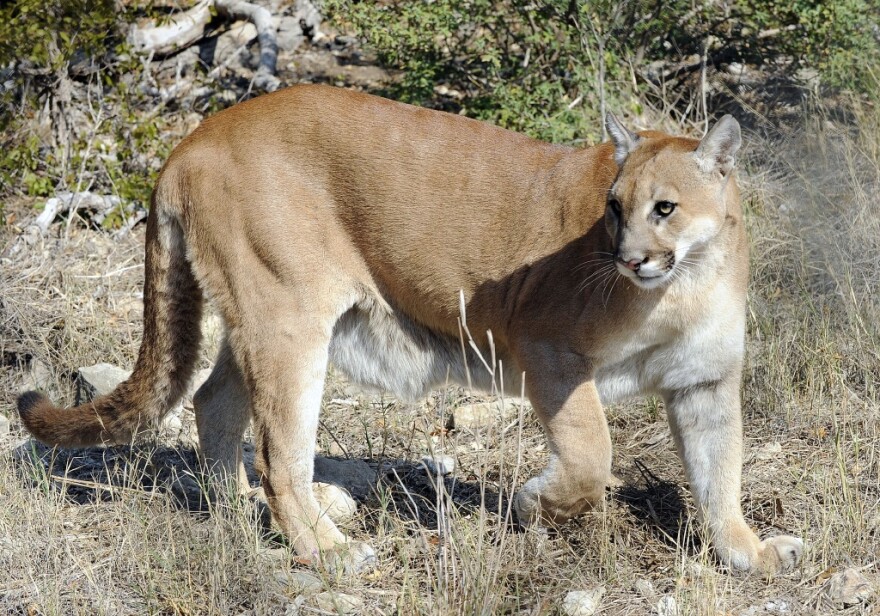Paul Schomer was sitting at home on Sunday afternoon when he felt eyes on him. A large spotted cat pressed its face against his sliding-glass door.
Schomer lives near Mount Bonnell, next to 200 acres of dense woods — a prime location for wildlife sightings.
“I get creatures of all kinds, but this was definitely a first," he said.
Schomer confirmed with the Texas Parks and Wildlife Department that the cat he saw was a bobcat. But many Austinites who catch a glimpse of a wild cat don't get a clear answer.
Was that a mountain lion or a bobcat? A puma or a cougar? What's the difference between them, and are they dangerous? Is it weird that they're in Austin to begin with?
I sat down with a few wildlife experts to hash all of this out.
Who's been sleeping in my shed?
First things first, if you do see a wild cat in Austin (and I'm not talking about a stray domestic cat), it’s almost certainly a bobcat.
Bobcats look like “super beefy house cats,” Jules Maron, executive director of Austin Wildlife Rescue, said. They weigh about 20-30 pounds and have spots, pointy ears and little “bobtails” for which they got their name.
They are surprisingly common in the Austin area. In fact, they could be sleeping under your porch right now.
Bobcats are smart and more adaptive to suburbia than other wild cats. They are small enough to make a den in your backyard, and they eat all the typical neighborhood fauna: birds, rats, squirrels and rabbits.
But, you should consider yourself lucky if you spot one, said Dana Karelus, a mammalogist with TPWD. Bobcats are shy, secretive and solitary. They're also crepuscular, meaning they're primarily out only during dawn and dusk.
What about mountain lions?
The chances of seeing a mountain lion in Austin, on the other hand, are near zero.
Mountain lions, also called pumas and cougars, are much bigger than bobcats. They look like small female lions — ranging from 7-8 feet long and weighing up to 140 pounds. They’re too big to make a home in someone’s backyard, and they feed on bigger prey, like deer and elk, that aren’t typically found in urban spaces.
In general, mountain lions aren't hanging out in rapidly growing Central Texas. The most confirmed mountain lion sightings in the state are out west near the border with Mexico.

But they are also known to travel hundreds of miles from their birthplace. About 15 years ago, a mountain lion was hit by a car and killed on a Connecticut highway. Scientists later used DNA evidence to determine it trekked more than 1,500 miles from South Dakota to get there.
So it's possible a mountain lion could wander from West Texas to Austin’s greenways, but Karelus said that’s probably wishful thinking.
This year, the closest confirmed mountain lion sighting to Austin by TPWD was in Runnels County, some 200 miles away. According to the agency, the closest confirmed sighting near Austin ever was in 2021 in Williamson County.
It's worth noting that TPWD has a high standard for what constitutes a confirmed sighting. Someone must submit a report that includes a photo of the cat, scat or tracks. (Now say that five times fast.)
“I’ve heard anecdotes of people seeing a mother mountain lion and kittens in [Austin], but somehow they never have a picture or they never actually submit it to us,” Karelus said.
Even if they were ubiquitous to Austin, it would still be difficult to see them because they are so secretive.
"Very few people will get the opportunity to even have a fleeting glance of them in the wild," Dillon Horger, director of animal care at Austin Zoo, said.
What if I see a wild cat in Austin?
Whether you see a bobcat or a mountain lion, the best thing to do is leave them be. Neither of them are known to attack humans. In fact, they don’t want anything to do with you.
“The [cats] aren’t really something to fear. They are so fearful themselves and so reclusive,” Maron said.
But bobcats could prey upon your pets, so keep a close eye on them if a bobcat is spotted in your neighborhood. If you see an injured bobcat, call Austin Wildlife Rescue. Staff will rehabilitate the animal and release it back into the wild.
Otherwise, Maron said, it's best to not interfere with nature's delicate balance of predator and prey animals. Bobcats help manage Austin's rodent population, and mountain lions keep remote areas from being overrun with deer.
“People are afraid of [predators] and don’t want them around," she said, "but then there's repercussions for that."








